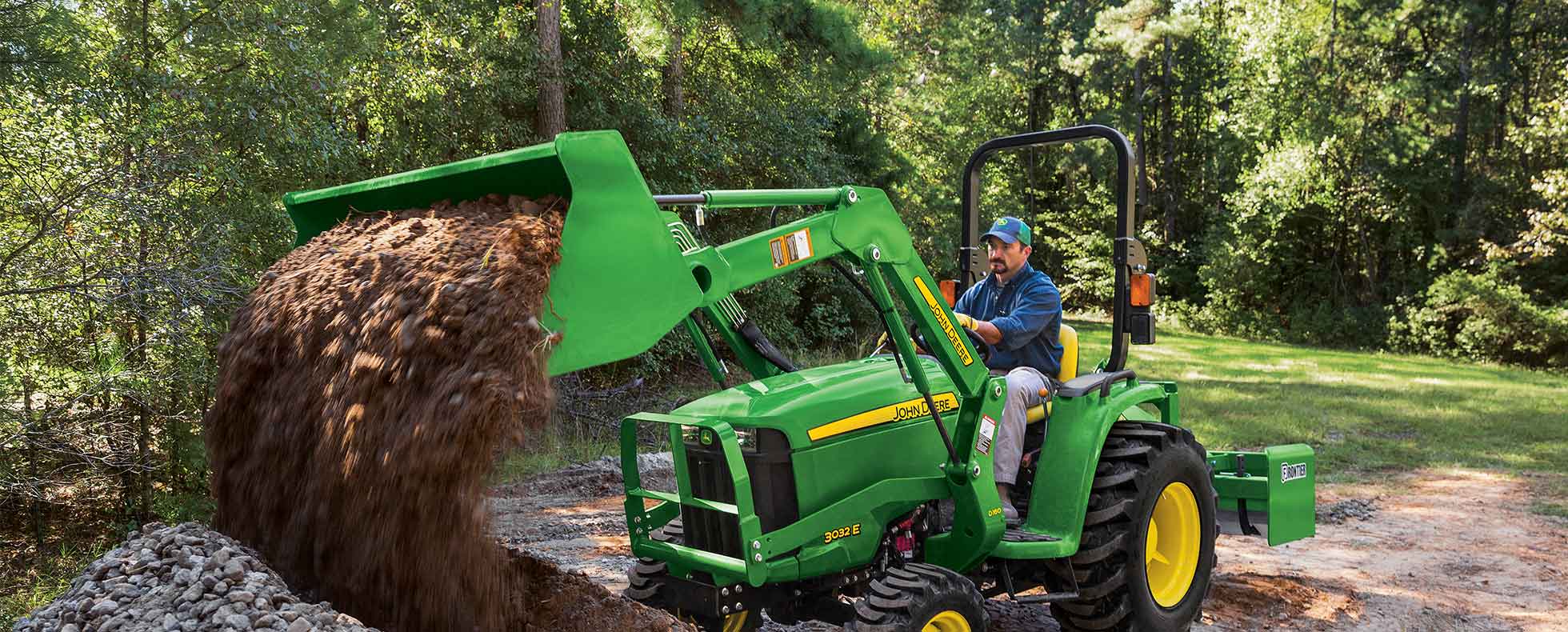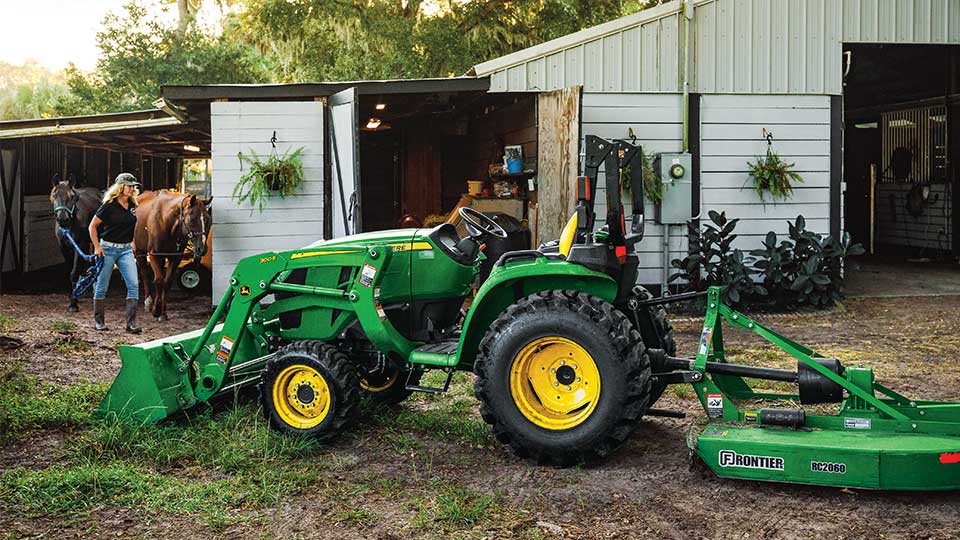
Choosing a compact utility tractor (CUT) isn’t easy. This is a big decision with many variables to consider.
Your first step is to choose a manufacturer. In this case, you’re looking at John Deere.
Great choice. Whether you’ve had John Deere products in your family or have heard great things about them, you’re on the right path.
At RDO Equipment Co., we’ve been selling John Deere’s products for over 50 years, connecting thousands of customers with the perfect machine for their needs.
Though there are many great manufacturers in space, John Deere consistently stands apart when it comes to CUTs.
Now you have to select a CUT model.
John Deere makes more than 20 compact utility tractor models across four series, which can be further divided into compact and sub-compact variations.
In this article, we’ll break down the differences between these two CUT categories and give you an idea of who each is a good fit for.
Sub-compact utility tractors are the smallest version of the compact tractor. You can identify these because they have a smaller frame than larger CUTs, have less than 30 horsepower, have smaller loaders/attachments and weigh less than compact utility tractors.
John Deere makes five sub-compact models. Each variation has slightly different specifications (between the E, R and D series) and sizes (between the 1, 2 and 3 series).
John Deere Sub-Compact Utility Tractor Models (as of 2025):
Specifications-wise, here’s what you can expect from sub-compact utility tractors:
Wheelbase range (smallest-largest): 57.1 inches (1023E) - 63 inches (2025R)
Shipping weight (lightest-heaviest): 1,446 pounds (1023E) - 2,778 pounds (3025D)
3 point hitch life capacity (lightest-heaviest): 758 pounds (1 Series) - 2,081.2 pounds (3025D)
Power take off power (least-most): 16.2 horsepower (1023E) - 20.7 horsepower (3025D)
Max front-axle clearance (lowest-highest): 7.7 inches (1 Series) - 13.1 inches (3025 D)
Front axle capacity (lightest-heaviest): 1,349 pounds (1 & 2 Series) - 1,940 pounds (2 Series)
Sub-compact tractors have a lot of versatility. Since these tractors are compatible with every properly sized three-point attachment, there’s no limit to the number of tasks they can perform.
As you can see above, John Deere offers plenty of size variance within its sub-compact tractor lineup, giving you room to find a machine that matches your requirements.
I typically recommend a sub-compact utility tractor to homeowners with some land to manage.
Often, these are individuals who live a rural lifestyle. Maybe they live on an acre, which they maintain through mowing, aerating, clearing debris, digging post holes, etc.
Or maybe they need help with snow removal and winter tasks around their property (particularly in the northern U.S.).
These people should consider a sub-compact tractor model, which will suit them well. There’s no need for a bigger machine.
Another reason I may point someone toward a sub-compact tractor is when space is a consideration and they need the smaller frame. This could be because the tractor must frequently navigate through gates, door openings or other tight spaces.
I also sell sub-compact models to commercial customers who use them to clear snow from sidewalks.
Sub-compact tractors can make a lot of sense in these situations.
Compact utility tractors reside between sub-compact tractors and utility tractors. These machines range between 30 and 75 horsepower and have a range of applications. Compared to sub-compact tractors, CUTs will have a larger frame, more lifting and axle capacity and typically weigh more.
John Deere’s CUT lineup consists of 18 models, starting with the 2032R and ending with the 4075R.
As of 2025, John Deere makes 18 CUTs across three series. This gives you a lot to consider when choosing the right one for you. Here’s a breakdown of John Deere CUTs.
2 Series CUTs
3 Series CUTs
4 Series CUTs
Yeah, a lot of options. You can compare all of these on John Deere’s website.
Generally speaking, you can expect these tractors to pack more “punch” than their sub-compact counterpart, making them a worthy ally regardless of your task.
Here are some broad specification ranges to consider when it comes to CUTs:
Wheelbase range (smallest-largest): 62.8 inches (3032E) - 73 inches (4 Series)
Shipping weight (lightest-heaviest): 2,222 pounds (3E Series) - 4,675 pounds (4R Series)
3-point hitch lift capacity (lightest-heaviest): 1,356 pounds (2 Series, 3E Series) - 2,709 pounds (4075R)
Power take off power (least-most): 24.2 horsepower (2032R) - 74.6 horsepower 4075R)
Max front-axle clearance (lowest-highest): 11.8 inches (3R Series) - 14.3 inches (3
E Series)
Front axle capacity (lightest-heaviest): 1,760 pounds (3E Series) - 3,528 pounds (4 Series)
Rear axle capacity (lightest-heaviest): 2,640 pounds (3E Series) - 5,292 pounds (4 Series)
While, between the 18 models, there is plenty of variance between the lows and highs of these ranges, compact utility tractors are generally more robust than sub-compact tractors.

Compact utility tractors are designed for more demanding tasks and larger properties than sub-compact tractors.
Their greater lift capacity, higher ground clearance and more robust performance make them suitable for landscaping, hauling heavy loads, managing a large amount of land (1 - 2+ acres) and even some small farming/ranching duties.
John Deere’s D Series models (the only line not manufactured in Augusta, GA) offer enhanced capabilities with features like gear-driven transmissions and increased weight for better stability and traction.
Compact utility tractors also come with emissions control systems, including diesel particulate filters (DPF), ensuring cleaner operation and compliance with the environmental standards regulating anything above 25 horsepower.
I find compact tractors are a better fit for users who require more power and versatility for their property maintenance.
If you have rocky terrain, need higher ground clearance or plan to undertake more substantial projects like building retaining walls or managing food plots, a compact tractor also provides the necessary strength and durability for these environments.
Commercial operators, equestrian facility owners and large property owners, for example, often prefer compact tractors because they can handle a wider range of tasks efficiently.

Choosing between a John Deere sub-compact and compact tractor ultimately comes down to understanding your needs and the specific tasks you plan to tackle.
By asking the right questions and seeking clear, honest answers, you can make an informed decision that ensures you get the most value and efficiency from your investment.
Sub-compact tractors are perfect for homeowners and small property owners who need a versatile, easy-to-maneuver machine for lighter, more sporadic tasks.
On the other hand, compact tractors offer the power and capacity necessary for more demanding projects, commercial operations and larger properties.
Whether you're maintaining your property, managing routine maintenance or running a commercial operation, knowing the strengths and limitations of each type of tractor will help you choose the right tool for the job. You can do a head-to-head comparison of each of them here.
If you have questions, contact our team at RDO. We’re happy to help you find the perfect solution for your needs.